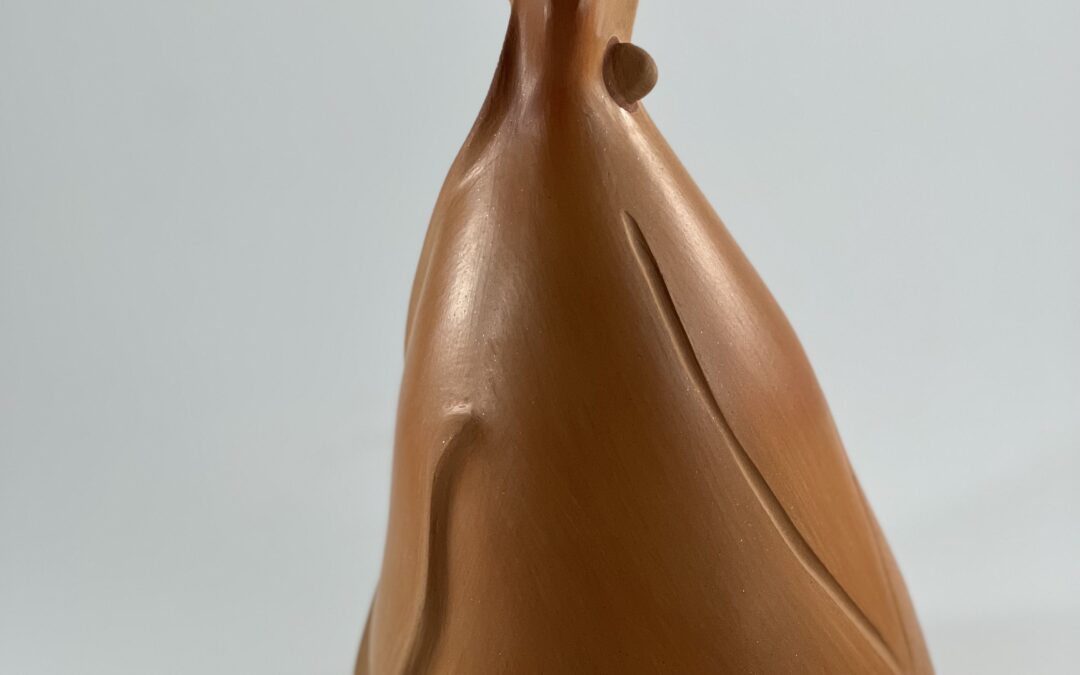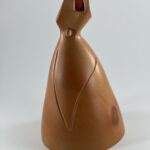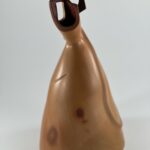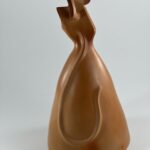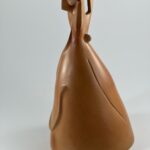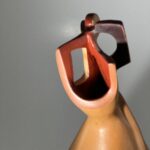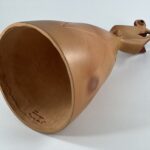This collection contains one of the earliest pots made by Les (1994-09), which seems quite traditional in both form and design. His work grows from his Tewa-Hopi and Zuni heritage, but as his career evolved both the forms of his clay vessels and his decoration of them often vary from this norm. His more recent work in this collection is kiln-fired before being decorated with unique abstract designs using acrylic paint: firing, paint, and design being at variance with Native tradition. Nevertheless, his work can have traditional Hopi-Tewa form (2020-02 and 2022-07). Occasionally I find work by Les whose iconography displays classic Hopi elements but whose form is unique (2016-02 and 2021-15). In short, Les is an artist with Native roots who is motivated by his own internal aesthetic and has thus created a wide variety of ceramics.
The abstract sculpture discussed here displays Les’ free will fully-realized. Its relationship to pueblo traditions is uncertain. “Form #1” is the only abstract sculpture by Les of which I am aware.
Form:
The interior is a perfect cone, except that it truncates with a small ball of clay at its apex, rather than ending at a point. The exterior is also cone-shaped, with modifications. As the exterior of the cone approaches its apex, it blossoms into a complex set of fins. The walls are even and substantial, but not thick.
Imagine a canoe with its bow cut off. The bow section would have an edge that would be “U-shaped” with the sides merging into a bow. Such —roughly— is the shape of 3 of the 4 fins on the apex of form 2023-06. One fin is the left side of the canoe bow, one is the right side, and they merge to form a third fin, the bow. The 4th fin is perpendicular to this cluster.
- Fin 1: The fin that forms the left side of the canoe bow has a rectangular cutout, like a doorway at Chaco Canyon.
- Fin 2: The fin that forms the right side of the canoe bow is solid and slightly shorter than fin 1.
- Fin 3: The top of the fin that forms the point of the bow has the shape of a 0.75-inch diameter circle with a 0.5-inch-wide circle of clay added to its left side. This circular element, like the figurehead on a ship, is the top of a large fin with an edge that slopes down and away from the surface of the cone, then turns and angles back to the cone’s surface.
- Fin 4: Fin 4 is perpendicular to the base of fin 3. Somewhat rectangular in shape, its short sides are parallel to the base of the cone. The top edge rises off the point of the bow, then becomes flat before falling directly to its bottom edge, which is not flat but curves gently to rejoin the surface of the cone. The center of fin 4 has been cut out to leave a semicircular hole, its circumference being cut off where the fin joins the surface of the cone.
This set of fins is not aligned with the axis of the cone, but slope slightly to one side.
The exterior side of the cone is inscribed with a large “V.” Each side of the “V” its is about 5-inches long, though both sides are irregular and somewhat curved. On the opposite side of the exterior of the form is a raised hook shape with an overall length of 12-inches, its height being 7-inches and the gap between point and shank being 2-inches.
On the interior edge of the cone Les has printed his name and the words “Form No. 1.”
Design:
At first glance the form seems to lack paint. A more studied look reveals that the cluster of fins is painted on its interior surfaces. The interior of the canoe bow formed by fins #1 and #2 is colored with a shiny brownish-red paint, which also colors the edge of the large, circular, bow element of fin 3. The side of fin 4 facing the bow is painted a shiny black. These are the only painted surfaces on the sculpture.
By design or chance the firing has left three fuzzy reddish blushes near one lower edge and two oval spots to the right of the tip of the inscribed “V.” The larger of these ovals is light reddish-brown and has more fuzzy edges than Its smaller neighbor. This small oval is a darker brown color.
Design Analysis:
“Form No. 1” can certainly be enjoyed for its shape devoid of any innate meaning. The slight tilt to the cluster of fins throws the form off balance a bit and gives it energy. The “V” and hook shapes on the surface of the cone interrupt this otherwise plain expanse and add interest, as do the five blushings. The color on the fins attracts the eye a bit, but the placement on the interior of the fins, the muted intensity of these colors, and their sparse use lessens the visual impact.
Les is of both Zuni and Tewa-Hopi heritage and both pueblos maintain a strong katchina culture. Viewers also bring their life experience as they interact with art, and I have had the good fortune to attend a number of Hopi katchina dances over the years. Thus I imagine Figure #1 might be an abstracted Salako Taka katchina with his impressive height and tabula headpiece. Les may (or may not) have has such an association in mind when he created this sculpture, but cultural heritage is stubborn and might find its way —either consciously or unconsciously– into the formation of a piece of art. It’s a beauty of art that it avoids fixed meanings.
I’m not generally attracted to purely abstract art, which is why —perhaps— I project a possible linkage to the Salako Taka katchina for “Form No. 1.” Having lived with the sculpture for a while, I find myself increasingly engaged with its form. I keep it on a window sill in my home and the shape changes with the changing light. Over time we have become friends and I’m changed by the relationship. Which is one definition of great art.

